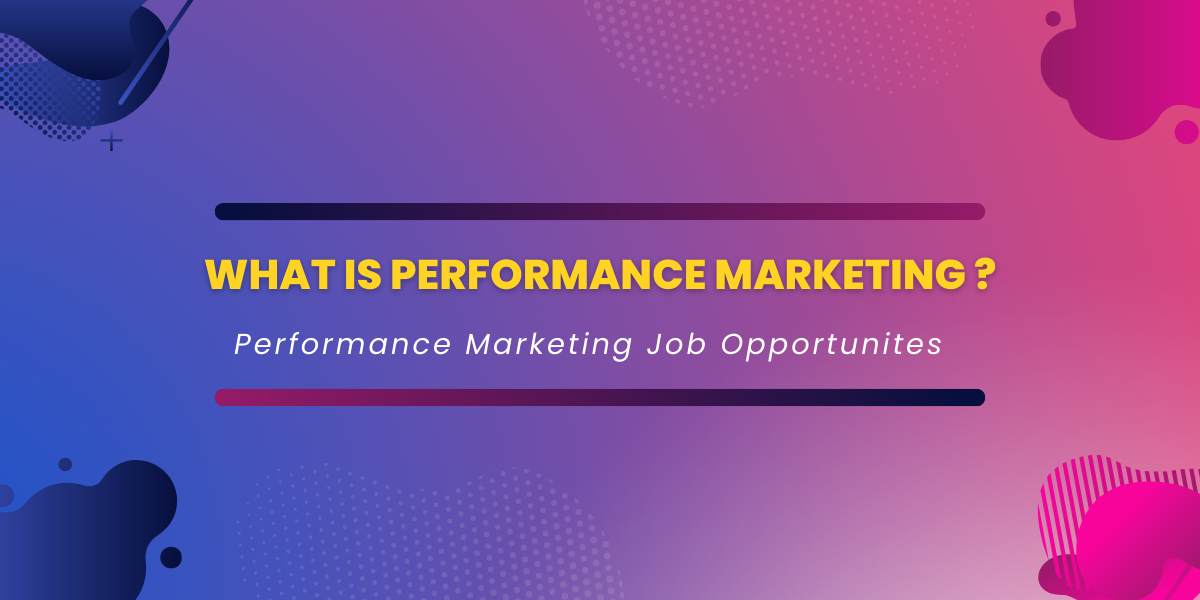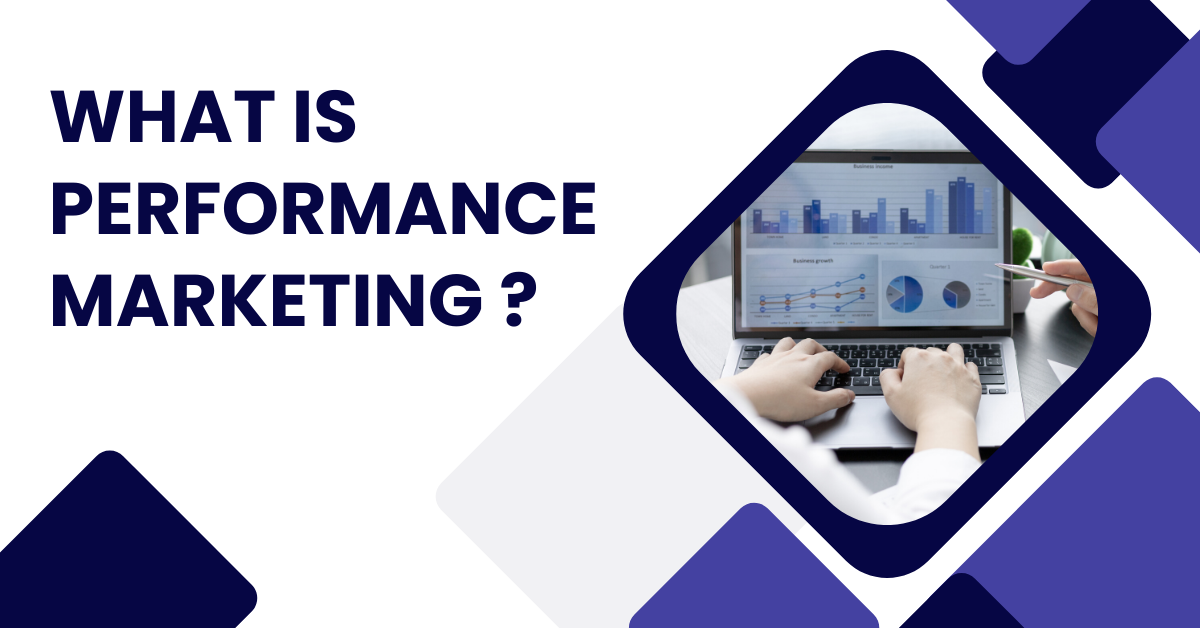Digital marketing is a big term that includes many strategies, and it’s always changing. One of these strategies that not everyone knows about is performance marketing. It’s different from the usual because advertisers only pay when certain things happen, like someone clicking on their ad or buying something. This makes it a smart and cost-effective choice for businesses. In this article, we’ll explore performance marketing in simple terms: what it does and why it’s helpful.

What is Performance Marketing ?
Performance marketing is a digital strategy focused on results. It’s great for companies wanting to reach a big audience because payment is based on how users interact with the content. Performance marketing means brands pay for marketing services only when they achieve their business goals or when specific actions happen, like a click, sale, or lead. It’s like paying for results. In performance marketing, advertisers collaborate with agencies or publishers to place ads on a range of platforms such as social media, search engines, videos, and websites. Instead of paying upfront like in traditional advertising, they pay based on how well the ad performs, such as clicks, views, shares, or sales
Five Types of Performance Marketing Channels:
Which channels are the most effective in performance marketing? Agencies and advertisers use five types of performance marketing to increase traffic:
-
Display Ads:
If you’ve been online, you’ve probably seen display ads on the side of your Facebook page or at the top or bottom of websites. While these ads are less effective now due to ad blockers and banner blindness, companies can still do well with eye-catching designs, interactive content, and videos in their display ads.
-
Native Advertising:
Native ads blend in with the web page or site they’re on to promote sponsored content. For example, you might see sponsored videos in the “Watch Next” section of a YouTube page. These ads are also common on e-commerce sites like Facebook Marketplace. They work because they look like regular content, making it natural for users to engage.
-
Content Marketing:
Content marketing is about educating your audience. It’s cost-effective, generating more leads than outbound marketing. The goal is to provide valuable information to users while showcasing your brand. For instance, a vitamin company might create informative blog posts about probiotics, linking back to their products. Content marketing includes blogs, case studies, e-books, and more.
-
Social Media Marketing:
Social media is a goldmine for marketers.It’s a great way to connect with users and direct them to your site. Plus, users can share their sponsored content naturally, reaching even more people.While Facebook is a standout platform, LinkedIn, Instagram, and Twitter also offer Excellent opportunities to reach new customers.
-
Search Engine Marketing (SEM):
Search engines are where most online research happens, making it crucial to have a site optimised for SEM. In performance marketing, CPC (Cost-Per-Click) is key for paid ads. Organic SEM often involves content marketing and SEO-focused landing pages for performance marketers.
How Performance Marketing Functions(works):
Implementing a performance marketing plan involves three main participants:
- The advertiser (like a shop or brand wanting better results)
- A publisher or affiliate (someone promoting for the advertiser)
- An affiliate tracking network (a third-party system connecting advertisers and publishers, tracking performance and managing payments).
How to Develop a Performance Marketing Plan?
-
Define your goals clearly:
When you start a digital marketing campaign, make sure you know what you want to achieve. What’s your aim? It could be raising brand awareness, selling more of a new product, getting more leads, or something else. For example, if you’re focusing on getting new leads, set a goal of getting 200 new leads. Once you have your goals, find the right publisher or partner to help you reach them.
-
Choosing the right publisher:
Choosing the right partner or publisher through research is key to increasing conversionsInfluencers are popular partners due to their strong audience trust. They can include affiliate links in videos or backlinks in written content.Define a payment structure, such as paying Google for impressions or clicks in SEM, or agreeing on payment terms with influencers when goals are met.
How do you know if performance marketing is working?
Advertisers place ads on chosen channels and pay based on how well the ad does. There are different ways to pay in performance marketing:
-
Cost per Click (CPC) /Pay Per Click:
Advertisers pay based on the clicks their ad receives. It’s an easy method to increase website traffic.
-
Cost Per Impression (CPM):
Impressions refer to how many times your ad is seen. With CPM you pay for every thousand views of your ad. For instance, if your ad gets 25,000 views, you’d pay based on your base rate multiplied by 25.
-
Cost Per Sales (CPS):
CPS (Cost Per Sale) means you pay only when an ad leads to a sale. It’s a common model in affiliate marketing too.
-
Cost per Lead (CPL)/Pay Per Lead:
Similar to cost per sale, CPL (Cost Per Lead) involves paying when someone signs up for something, such as an email newsletter or webinar. CPL helps generate leads, allowing you to follow up with potential customers and boost sales.
-
Cost per Acquisition (CPA)/Pay Per Sale:
Cost per acquisition (CPA) is akin to CPL and CPS but is broader in scope. Under this model, advertisers pay when consumers take a specific action, such as making a purchase, sharing contact details, or visiting a blog.
Benefits of Performance marketing:
Performance marketing is an excellent choice for businesses because it’s cost-effective and allows you to reach a broader audience. You only pay for actual results like clicks or conversions, which saves money. Additionally, it provides valuable data to improve your campaigns and offers creative ways to engage customers. It’s a smart strategy for growing your business without overspending.
What are Performance-Base Ads?
Performance-based advertising is a digital marketing approach where advertisers pay based on specific user actions, like clicking an ad, making a purchase, or signing up. Unlike traditional methods where payment is for ad views, this model ensures costs align with actual results, making it more efficient for advertisers.
Performance marketing is a digital advertising strategy where advertisers pay based on specific actions users take, like clicking an ad or making a purchase, rather than just for ad views. It’s efficient because costs are tied directly to results, making it easier to measure ROI and optimise campaigns.
Performance Marketing – FAQ
-
Is Performance-based marketing not a scam?
Performance-based marketing is a reliable and effective strategy, not a scam. It’s a valuable industry for businesses, as advertisers charge fees based on actual performance metrics such as clicks or conversions. This approach ensures targeted and efficient investments, especially in areas like remarketing and brand bidding.
-
What is the role of Performance Marketing?
Performance marketing plays a crucial role in online advertising by focusing on measurable results and actions, which are essential for customer acquisition and retention.
-
Is performance marketing a SEO?
No, performance marketing is not the same as SEO. SEO focuses on improving your website’s visibility in search engines organically, while performance marketing involves paying for specific actions like clicks or conversions to achieve measurable results.
Performance Marketing is the latest marketing trend to go viral in marketing.
Read More,

